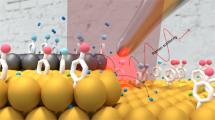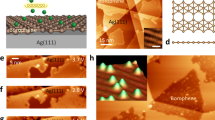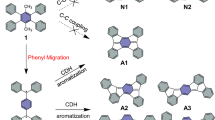Abstract
An atomic- and molecular-level understanding of heterogeneous catalysis is required to characterize the nature of active sites and improve the rational design of catalysts1,2,3. Achieving this level of characterization requires techniques that can correlate catalytic performances to specific surface structures, so as to avoid averaging effects1. Tip-enhanced Raman spectroscopy4,5,6,7 combines scanning probe microscopy with plasmon-enhanced Raman scattering and provides simultaneous topographical and chemical information at the nano/atomic scale from ambient8,9,10 to ultrahigh-vacuum11,12 and electrochemical environments13,14. Therefore, it has been used to monitor catalytic reactions15,16,17,18 and is proposed to correlate the local structure and function of heterogeneous catalysts19. Bimetallic catalysts, such as Pd–Au, show superior performance in various catalytic reactions20,21, but it has remained challenging to correlate structure and reactivity because of their structural complexity. Here, we show that TERS can chemically and spatially probe the site-specific chemical (electronic and catalytic) and physical (plasmonic) properties of an atomically well-defined Pd(sub-monolayer)/Au(111) bimetallic model catalyst at 3 nm resolution in real space using phenyl isocyanide as a probe molecule (Fig. 1a). We observe a weakened N≡C bond and enhanced reactivity of phenyl isocyanide adsorbed at the Pd step edge compared with that at the Pd terrace. Density functional theory corroborates these observations by revealing a higher d-band electronic profile for the low-coordinated Pd step edge atoms. The 3 nm spatial resolution we demonstrate here is the result of an enhanced electric field and distinct electronic properties at the step edges.
This is a preview of subscription content, access via your institution
Access options
Subscribe to this journal
Receive 12 print issues and online access
$259.00 per year
only $21.58 per issue
Buy this article
- Purchase on Springer Link
- Instant access to full article PDF
Prices may be subject to local taxes which are calculated during checkout




Similar content being viewed by others
References
Buurmans, I. L. C. & Weckhuysen, B. M. Heterogeneities of individual catalyst particles in space and time as monitored by spectroscopy. Nat. Chem. 4, 873–886 (2012).
Ding, K. et al. Identification of active sites in CO oxidation and water-gas shift over supported Pt catalysts. Science 350, 189–192 (2015).
Chen, G. et al. Interfacial effects in iron-nickel hydroxide-platinum nanoparticles enhance catalytic oxidation. Science 344, 495–499 (2014).
Stöckle, R. M., Suh, Y. D., Deckert, V. & Zenobi, R. Nanoscale chemical analysis by tip-enhanced Raman spectroscopy. Chem. Phys. Lett. 318, 131–136 (2000).
Anderson, M. S. Locally enhanced Raman spectroscopy with an atomic force microscope. Appl. Phys. Lett 76, 3130–3132 (2000).
Hayazawa, N., Inouye, Y., Sekkat, Z. & Kawata, S. Metallized tip amplification of near-field Raman scattering. Opt. Commun. 183, 333–336 (2000).
Pettinger, B., Schambach, P., Villagómez, C. J. & Scott, N. Tip-enhanced Raman spectroscopy: near-fields acting on a few molecules. Annu. Rev. Phys. Chem. 63, 379–399 (2012).
Berweger, S. et al. Optical nanocrystallography with tip-enhanced phonon Raman spectroscopy. Nat. Nanotech. 4, 496–499 (2009).
Liu, Z. et al. Revealing the molecular structure of single-molecule junctions in different conductance states by fishing-mode tip-enhanced Raman spectroscopy. Nat. Commun. 2, 305 (2011).
Yano, T. A. et al. Tip-enhanced nano-Raman analytical imaging of locally induced strain distribution in carbon nanotubes. Nat. Commun. 4, 2592 (2013).
Zhang, R. et al. Chemical mapping of a single molecule by plasmon-enhanced Raman scattering. Nature 498, 82–86 (2013).
Jiang, S. et al. Distinguishing adjacent molecules on a surface using plasmon-enhanced Raman scattering. Nat. Nanotech. 10, 865–869 (2015).
Zeng, Z.-C. et al. Electrochemical tip-enhanced Raman spectroscopy. J. Am. Chem. Soc. 137, 11928–11931 (2015).
Kurouski, D., Mattei, M. & Van Duyne, R. P. Probing redox reactions at the nanoscale with electrochemical tip-enhanced Raman spectroscopy. Nano Lett. 15, 7956–7962 (2015).
van Schrojenstein Lantman, E. M., Deckert-Gaudig, T., Mank, A. J. G., Deckert, V. & Weckhuysen, B. M. Catalytic processes monitored at the nanoscale with tip-enhanced Raman spectroscopy. Nat. Nanotech. 7, 583–586 (2012).
Sun, M., Zhang, Z., Zheng, H. & Xu, H. In-situ plasmon-driven chemical reactions revealed by high vacuum tip-enhanced Raman spectroscopy. Sci. Rep. 2, 647 (2012).
Kumar, N., Stephanidis, B., Zenobi, R., Wain, A. J. & Roy, D. Nanoscale mapping of catalytic activity using tip-enhanced Raman spectroscopy. Nanoscale 7, 7133–7137 (2015).
Domke, K. F. & Pettinger, B. In situ discrimination between axially complexed and ligand-free Co porphyrin on Au(111) with tip-enhanced Raman spectroscopy. ChemPhysChem 10, 1794–1798 (2009).
Hartman, T., Wondergem, C. S., Kumar, N., van den Berg, A. & Weckhuysen, B. M. Surface- and tip-enhanced Raman spectroscopy in catalysis. J. Phys. Chem. Lett. 7, 1570–1584 (2016).
Chen, M., Kumar, D., Yi, C.-W. & Goodman, D. W. The promotional effect of gold in catalysis by palladium-gold. Science 310, 291–293 (2005).
Zhang, H., Watanabe, T., Okumura, M., Haruta, M. & Toshima, N . Catalytically highly active top gold atom on palladium nanocluster. Nat. Mater. 11, 49–52 (2012).
Nenajdenko, V. G . (ed.) Isocyanide Chemistry: Applications in Synthesis and Material Science (Wiley-VCH, 2012).
Hu, J., Tanabe, M., Sato, J., Uosaki, K. & Ikeda, K. Effects of atomic geometry and electronic structure of platinum surfaces on molecular adsorbates studied by gap-mode SERS. J. Am. Chem. Soc. 136, 10299–10307 (2014).
Hu, J., Hoshi, N., Uosaki, K. & Ikeda, K. Vibrational spectroscopic observation of atomic-scale local surface sites using site-selective signal enhancement. Nano Lett. 15, 7982–7986 (2015).
Lazar, M. & Angelici, R. J. Gold metal-catalyzed reactions of isocyanides with primary amines and oxygen: analogies with reactions of isocyanides in transition metal complexes. J. Am. Chem. Soc. 128, 10613–10620 (2006).
Stapleton, J. J. et al. Self-assembly, characterization, and chemical stability of isocyanide-bound molecular wire monolayers on gold and palladium surfaces. Langmuir 21, 11061–11070 (2005).
Zhang, W. H. et al. Nanoscale roughness on metal surfaces can increase tip-enhanced Raman scattering by an order of magnitude. Nano Lett. 7, 1401–1405 (2007).
Barbry, M. et al. Atomistic near-field nanoplasmonics: reaching atomic-scale resolution in nanooptics. Nano Lett. 15, 3410–3419 (2015).
Hammer, B. & Nørskov, J. K. Theoretical surface science and catalysis—calculations and concepts. Adv. Catal. 45, 71–129 (2000).
Kresse, G., Gil, A. & Sautet, P. Significance of single-electron energies for the description of CO on Pt(111). Phys. Rev. B 68, 073401 (2003).
Giannozzi, P. et al. QUANTUM ESPRESSO: a modular and open-source software project for quantum simulations of materials. J. Phys. Condens. Matter 21, 395502 (2009).
Acknowledgements
The authors acknowledge support from MOST (2016YFA0200601, 2013CB933703 and 2011YQ03012400), NSFC (21633005, 21227004, 21321062 and J1310024) and MOE (IRT13036). The authors thank J.M. Feliu, N. Zheng, D.-Y. Wu, M. Zhang, X.-G. Zhang and A. Terfort for discussions, S. Mo for assistance with ICP-MS measurements and Y. Zheng for help with XPS measurements. The authors acknowledge the National Supercomputer Center in Guangzhou for Tianhe-2 CPU time and assistance. C.T.W. acknowledges support from the PCOSS fellowship programme.
Author information
Authors and Affiliations
Contributions
B.R. supervised the project. J.-H.Z. and B.R. conceived the ideas. J.-H.Z., X.W. and H.-S.S performed the experiments. X.J. performed electronic structure and vibrational frequency calculations. L.M. and Z.-L.Y. performed electromagnetic field simulations. C.T.W. helped with experiments and analysis. All authors contributed to data interpretation and writing of the manuscript.
Corresponding author
Ethics declarations
Competing interests
The authors declare no competing financial interests.
Supplementary information
Supplementary information
Supplementary information (PDF 2613 kb)
Rights and permissions
About this article
Cite this article
Zhong, JH., Jin, X., Meng, L. et al. Probing the electronic and catalytic properties of a bimetallic surface with 3 nm resolution. Nature Nanotech 12, 132–136 (2017). https://doi.org/10.1038/nnano.2016.241
Received:
Accepted:
Published:
Issue Date:
DOI: https://doi.org/10.1038/nnano.2016.241
This article is cited by
-
Noise learning of instruments for high-contrast, high-resolution and fast hyperspectral microscopy and nanoscopy
Nature Communications (2024)
-
Direct observation of accelerating hydrogen spillover via surface-lattice-confinement effect
Nature Communications (2023)
-
Recent advances in tip-enhanced Raman spectroscopy probe designs
Nano Research (2023)
-
Investigating heterogeneous defects in single-crystalline WS2 via tip-enhanced Raman spectroscopy
npj 2D Materials and Applications (2022)
-
Chemically identifying single adatoms with single-bond sensitivity during oxidation reactions of borophene
Nature Communications (2022)



